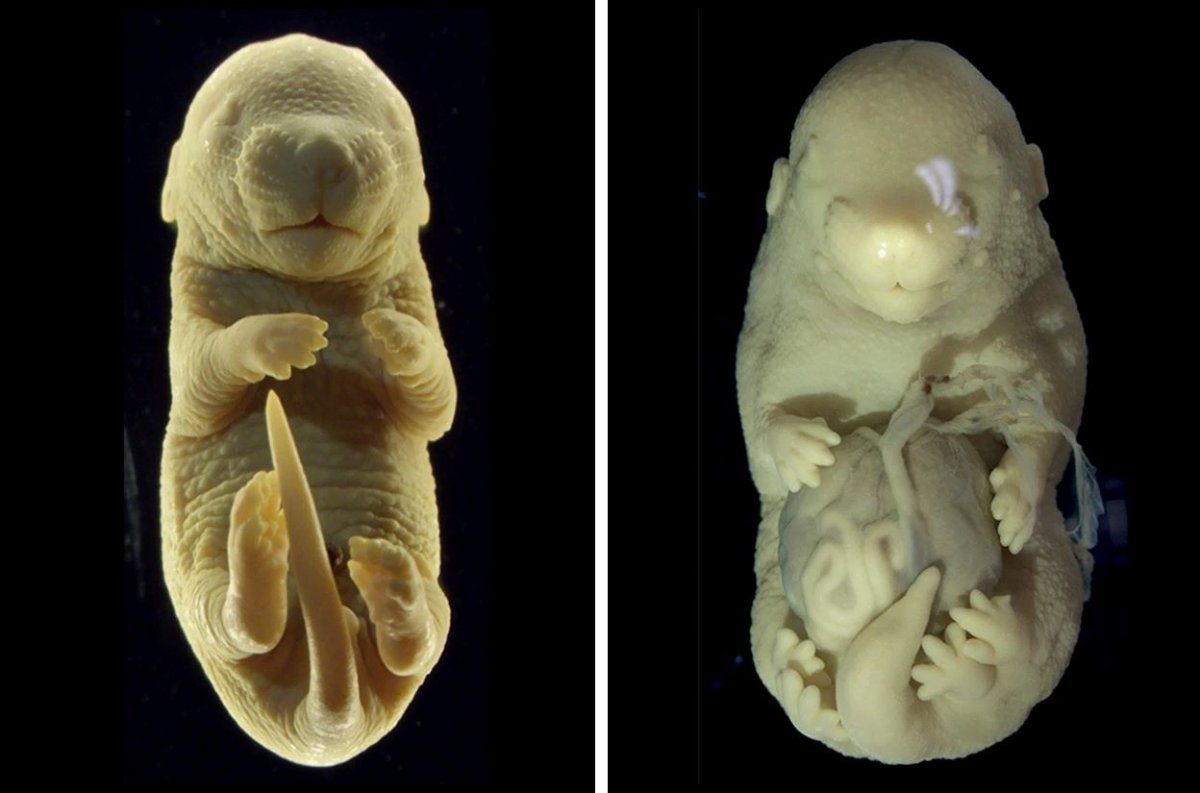Scientists have created a 6-legged mouse embryo with an extra pair of hindlimbs at the expense of their external genitalia. But far from creating a monster, this rudimentary rodent provides important insights into the early stages of animal development and uncovers secrets about our own evolution.
We all start our lives as a microscopic, limbless bean that gradually grows arms and legs as a result of a complex network of chemical instructions. These instructions tell certain genes to switch on and off depending on where they are located in the body. And these instructions become more and more specific as we grow.
For example, at the beginning, a cell might just know that it's located somewhere near the top of the growing group of cells. But later down the line, this cell learns that it is located on the left side of the head and is destined to become one of the hair-like cells in our inner ear.

One important group of chemical instructions is the TGF-β family of growth factors. To respond to these growth factors, cells produce a complementary family of receptors. One key receptor, known as Tgfβ receptor 1, or Tgfbr1, is known to play an important role in controlling the formation of hindlimbs and external genitalia.
To investigate the role of this chemical crosstalk in embryonic development, a team of researchers at the Gulbenkian Science Institute in Oeiras, Portugal, inactivated the gene encoding the Tgfbr1 receptor halfway through the development of mouse embryos. Their results were published in the journal Nature Communications.
Originally, the team, led by Moisés Mallo, was interested in how this change in gene expression might impact the development of the spinal cord. However, what they found was totally unexpected: the development of two additional hindlimbs in the place of external genitalia.
"[We were] very surprised," Mallo told Newsweek.
Probing further, the team found that Tgfbr1 dictates whether our limb buds develop into hindlimbs or genitals by altering the way that DNA folds inside the cells in these limb structures. So by deactivating Tgfbr1, the team inadvertently changed the expression of other genes inside the mouse embryo's cells, resulting in its extra pair of legs.
"Our work uncovers a remarkable tissue plasticity with potential implications in the evolution of the hindlimb/genital area of [four-legged animals]," the authors write.
The researchers hope that by improving our understanding of these early developmental pathways we can gain important insights into the underlying mechanisms of various developmental diseases.
While these studies were performed in mice, our early developmental pathways are fairly well conserved across different mammals because any small changes in their function have drastic (and often detrimental) effects on the development of the growing organism. Therefore, we can translate a lot of what we know from mouse embryos into human development.
"I would actually expect the same would happen in humans, but of course, this cannot be experimentally tested," Mallo said.
At this point, there is still a lot left to learn about the early biochemistry of mammalian development. However, Mallo said that studies like this do provide important pieces to the puzzle of how our ancestors actually evolved.
"It is thought that limbs developed from the fins of aquatic vertebrates when they left water to conquer dry land," Mallo said. "During this process, contrary to what happens in fishes, the pelvic appendage (hindlimb in tetrapods, pelvic fin in fishes) develop in the same embryonic space as the external genitalia. This implies that their development must be very precisely coordinated in order to generate hindlimbs that allow locomotion in their ecological niche, as well as compatible genitals that allow mating.
"This was solved by the acquisition of a common regulatory mechanism involving a considerable share of the regulatory factors. Modulation of the response to those factors provided enough plasticity to generate the required diversity in the area of the hindlimb/genital area of tetrapods adapted to different ecological niches."
In other words, the ability of our genital buds to develop into hindlimbs demonstrates a plasticity that enabled our ancestors to descend down different pathways of evolution to develop the most suitable body plans for their environment.
Who knew mutant mice could tell us so much about our own history?
Is there a health problem that's worrying you? Do you have a question about embryonic development? Let us know via health@newsweek.com. We can ask experts for advice, and your story could be featured on Newsweek.
Update 04/04/24, 2:16 p.m. ET: This article was updated with comment from Moisés Mallo.
Uncommon Knowledge
Newsweek is committed to challenging conventional wisdom and finding connections in the search for common ground.
Newsweek is committed to challenging conventional wisdom and finding connections in the search for common ground.
About the writer
Pandora Dewan is a Senior Science Reporter at Newsweek based in London, UK. Her focus is reporting on science, health ... Read more





